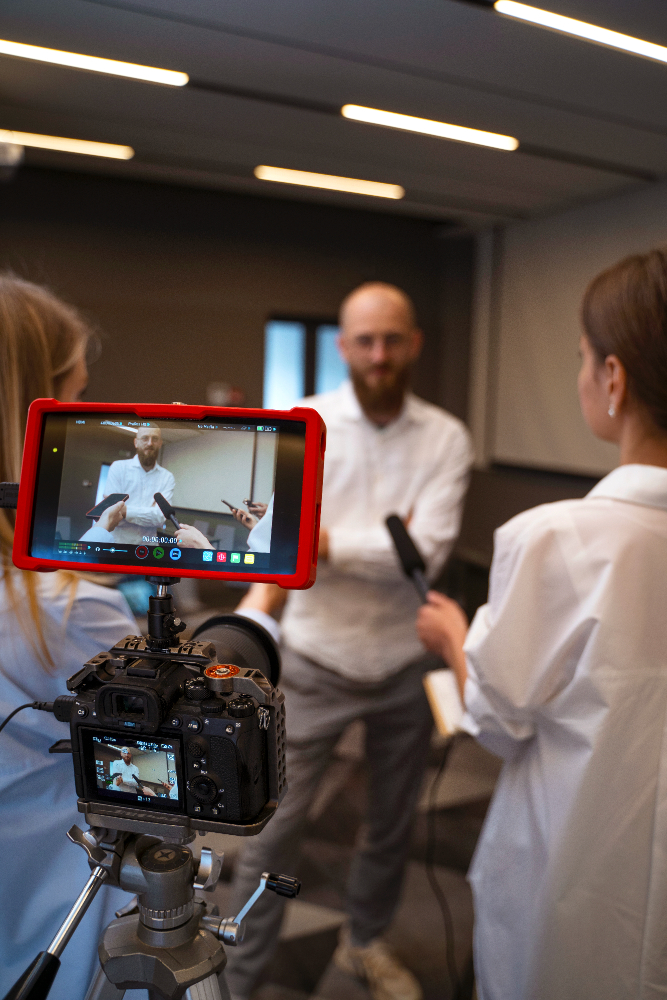In the digital age, video marketing has emerged as a powerful tool for engaging audiences, building brand awareness, and driving conversions. With platforms like YouTube, Instagram, TikTok, and LinkedIn catering to video-first consumption, brands are increasingly leveraging visual content to stand out in a crowded marketplace. This blog explores actionable video marketing strategies to help you create compelling visual content that resonates with your audience and delivers measurable results.

Why Video Marketing Matters
Video marketing has grown exponentially in recent years due to its effectiveness in capturing attention and conveying complex information in an easily digestible format. Here’s why it should be part of your strategy:
- Higher Engagement Rates: Videos are more likely to be shared, liked, and commented on than other types of content.
- Increased Conversion Rates: Landing pages with video content can boost conversions by up to 80%.
- Enhanced Information Retention: Viewers retain 95% of a message when they watch it in a video compared to just 10% when reading it.
- Versatility: Video works across multiple platforms and formats, from educational webinars to entertaining TikTok clips.
1. Define Your Goals
Every successful marketing strategy begins with clear objectives. Before diving into video production, determine what you want to achieve. Common goals include:
- Increasing brand awareness
- Generating leads
- Driving website traffic
- Boosting sales
- Educating your audience
Pro Tip:
Align your goals with your overall marketing objectives and decide on the metrics you’ll use to measure success, such as views, click-through rates, or engagement levels.
2. Know Your Audience
Understanding your target audience is crucial for creating video content that resonates. Research their demographics, preferences, and pain points. Use tools like Google Analytics, social media insights, and surveys to gather data.
Audience Insights to Consider:
- Preferred Platforms: Younger audiences might favor Instagram and TikTok, while professionals may lean toward LinkedIn.
- Content Preferences: Do they prefer educational tutorials, entertaining stories, or product demonstrations?
- Viewing Habits: Are they watching on mobile devices or desktops? At what time of day are they most active?
3. Choose the Right Video Format
Not all videos serve the same purpose. Choosing the right format based on your goals and audience preferences is critical. Here are some popular video formats:
a. Explainer Videos: Explain complex ideas, products, or services in a simple, engaging manner. Perfect for B2B and tech industries.
b. How-To Tutorials: Educational content that adds value and positions your brand as an industry expert.
c. Product Demos: Showcase your product’s features and benefits, especially useful for e-commerce.
d. Behind-the-Scenes: Humanize your brand by giving audiences a glimpse into your processes or team culture.
e. Testimonial Videos: Leverage the power of social proof by sharing customer success stories.
f. Live Streams: Engage audiences in real-time, answer questions, and create a sense of immediacy.
4. Focus on Storytelling
People connect with stories, not sales pitches. Weave narratives into your videos to evoke emotions and create memorable experiences. A compelling story typically has three elements:
- Problem: Highlight an issue your audience faces.
- Solution: Showcase how your product or service solves it.
- Transformation: Illustrate the positive outcome after using your solution.
Example:
A fitness brand can create a video showing someone struggling with energy levels, discovering their product, and then achieving peak performance.

5. Optimize for Mobile Viewing
With mobile devices accounting for the majority of video consumption, optimizing your videos for mobile is non-negotiable.
Tips for Mobile Optimization:
- Use vertical video formats for platforms like Instagram Stories and TikTok.
- Keep videos short and concise (under 60 seconds for social platforms).
- Include captions since many viewers watch videos on mute.
6. Leverage Social Media Platforms
Each social media platform has unique features and audience behaviors. Tailor your video content to maximize impact on each platform:
- YouTube: Ideal for long-form content like tutorials and product reviews. Optimize with SEO-friendly titles and descriptions.
- Instagram: Perfect for short, visually appealing videos in Stories, Reels, and posts.
- TikTok: Focus on creative, entertaining, and trend-driven content.
- LinkedIn: Share professional, educational, or thought-leadership videos.
- Facebook: Use a mix of live videos, ads, and storytelling content to engage diverse demographics.
7. Use Eye-Catching Thumbnails and Titles
Your video thumbnail and title are the first things potential viewers see. Make them count.
Tips:
- Use bright, contrasting colors for thumbnails.
- Incorporate bold text to highlight key themes.
- Write titles that are concise and include keywords for SEO.
8. Focus on the First Few Seconds
The first 5-10 seconds of your video are crucial for capturing attention.
Strategies:
- Pose a provocative question.
- Use a compelling hook or statistic.
- Highlight the benefit viewers will gain by watching.
9. Add a Clear Call-to-Action (CTA)
Every video should guide viewers toward a desired action, whether it’s visiting your website, signing up for a newsletter, or making a purchase.
CTA Examples:
- “Click the link in our bio to learn more.”
- “Subscribe to our channel for weekly updates.”
- “Sign up now for exclusive discounts.”
10. Track Performance and Optimize
Monitor the performance of your videos to understand what works and refine your strategy. Key metrics to track include:
- View Count: Measures reach.
- Engagement Rate: Indicates how well your video resonates.
- Click-Through Rate (CTR): Shows how effective your CTA is.
- Conversion Rate: Measures the success of your video in driving desired actions.
Use tools like YouTube Analytics, Facebook Insights, and Google Analytics to gather data.
Advanced Strategies for Video Marketing Success
1. Interactive Videos
Incorporate clickable elements, quizzes, or polls within your videos to boost engagement.
2. Personalized Videos
Address viewers by name or tailor content to their preferences for a more customized experience.
3. Video Retargeting
Use retargeting ads to re-engage viewers who didn’t convert after watching your video.
4. Collaborations and Influencer Partnerships
Partner with influencers or other brands to tap into their audiences and add credibility to your message.
5. Augmented Reality (AR) Videos
Create immersive experiences by integrating AR elements into your videos.

Case Studies: Brands Excelling in Video Marketing

1. Nike
Nike’s storytelling-focused videos, like its “Just Do It” campaigns, inspire and emotionally connect with audiences, driving both brand loyalty and sales.
2. BuzzFeed’s Tasty
Tasty’s short, visually appealing recipe videos have made it a leader in the food content space, leveraging both entertainment and utility.
3. Zomato
In India, Zomato uses quirky, relatable, and engaging video content across social media to resonate with its audience, showcasing its personality and boosting engagement.
Conclusion
The Future of Video Marketing
Video marketing isn’t just a trend—it’s a critical element of a successful digital strategy. By understanding your audience, creating compelling content, and leveraging data to refine your approach, you can build deeper connections and achieve your business goals. As technology advances, opportunities for innovation in video marketing will continue to expand, from AR to shoppable videos.
By staying creative and focused, your brand can harness the full potential of visual content to captivate, engage, and convert your audience.
